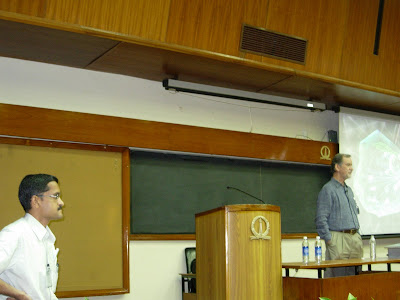Program Schedule: PDF
INTERNATIONAL SYMPOSIUM ON INTERFACE BETWEEN CHEMISTRY AND BIOLOGY INDIAN INSTITUTE OF SCIENCE CAMPUS and in National Centre for Biological Sciences (TIFR) Bangalore
February 17- 19th 2009: This symposium brings together researchers from diverse areas like chemists, spectroscopists and molecular biologists who address fundamental problems in biology using chemical techniques. The symposium will cover areas like Peptide Conformation and Design, Membrane Biology, Structural Bioinformatics, Protein Engineering, Protein Folding and Drug Discovery, Chemical Ecology amongst other topics.
PROGRAM SCHEDULE 17th February, 2009
Venue: Indian Institute of Science, Faculty HallPlenary session
Chair: D.N. Rao
9:55 – 10:00 am Opening Remarks by D.N. Rao
10:00 – 10.45 am Plenary Lecture by Victor Hruby
Developing New Paradigms for Drug Design for Disease
10:45 – 11:15 am Tea breakChair: Siddartha Sarma
11:15 to 11:45 am Satyajit Mayor
A hierarchy of scales: The tale of the morphogen, Hedgehog
11:45 am – 12:15 pm S. Sikdar
How does epileptiform activity affect Ca dynamics in neurons?
12:15 – 12:45 pm M.K. Mathew
Potassium Channel Opening: A Subtle Two-Step
12:45 pm to 2:00 pm LUNCHChair: Manju Bansal
2:00– 2:30 pm K.S. Krishnan
Synaptic Vesicle Recycling
2:30 – 3:00 pm K.N. Ganesh
Discovering unknown HIV Tat - NFkB interactions: Novel Applications of SELEX
3:00 – 3:30 pm Anna Spudich
Early European Records of Medicinal Plants of India: a valuable resource for drug discovery
3:30 to 4 pm Tea BreakChair: C. Ramakrishnan
4:00 to 4:30 pm: J. Ramirez
Peptidergic and Aminergic Modulation of Respiratory Network Activity
4:30 to 5:00 pm: Raghavan Varadarajan
Influenza immunogen design
5:00 to 5:30 pm: Ramasarma
Vanadium Redox in Biological Oxidations
18th February 2009
Venue: Indian Institute of Science, Faculty HallChair: B. Gopal
9:30 to 10 am: Jim Spudich
Single molecule and computational analyses reveal how the mysterious myosin VI molecular motor works
10 to 10:30 am: M.R.N. Murthy
New Insights into the structure and function of serinehydroxymethyl transferase
10.30to 11 am: Tea breakChair: R. Sowdhamini
11 to 11:30 am : N. Shamala
Crystallographic Studies of Designed Peptides
11:30 am to 12 noon: Suman Thakur
Negative Ion Mass Spectrometry of Intact Disulfides and Bioactive Peptides
Chair: Nagasuma Chandra
12 to 12:30 pm: Saraswathi Vishweshwara
Long distance communication in proteins: Network dynamics of tRNA Synthetases
12:30 to 1 pm: R. Sowdhamini
Analysis of disulphide bond conservation within protein families
1 to 2 pm: LUNCHChair: Dipankar Chatterji
2 to 2:30 pm: Rajesh Ghokale
Role of Multifunctional Polyketide Synthases in Dictyostelium Development
2:30 to 3 pm: Hemalatha Balaram
Purine nucleotide synthesis in Plasmodium falciparum
3 to 3:30 pm: R. Nagaraj
Self-association of peptides on surfaces
3:30 to 4 pm: Tea BreakChair: N. Srinivasan
4 to 4:30 pm: Tapas Kumar Kundu
Small molecules targeting epigenetic modifications, implications in gene expression from differentiation to disease
4:30 to 5 pm: Ranganathan
Exploration of pathways in silica solubilizatiion and biosilicification
19th February 2009
Venue: National Centre for Biological Sciences (TIFR)Chair: P. Gautam
9:30 to 10 am: Jayant Udgaonkar
Hydrogen exchange-mass spectrometric characterization of the individual steps during the unfolding of a small protein
10 to 10:30 am: P. Babu
Lactase persistence mutations: An inspiration for DNA-DNA interaction?
10:30 to 11 am: Anil Kumar
Determination of three-dimensional structures of non-crystalline proteins in Solution by NMR
11 to 11:30 am: Tea BreakChair: S. Brahmachari
11:30 to 12 noon: V.S. Chauhan
Peptide Design: From Models to Applications
12:00 to 12:30 pm: Mani Ramaswami
The control of mRNA translation: microRNAs, neurological disease and memory
12:30 to 1 pm: D. Balasubramanian
Optineurin and its Mutants: Molecules Associated With Some Forms of Glaucoma
1 to 3:30 pm: LUNCH and POSTER SESSION3:30 pm: Closing Remarks by Prof. VijayRaghavan and others
5:30 pm: High Tea http://www.ncbs.res.in/index.php?option=com_content&task=view&id=383&Itemid=9








































